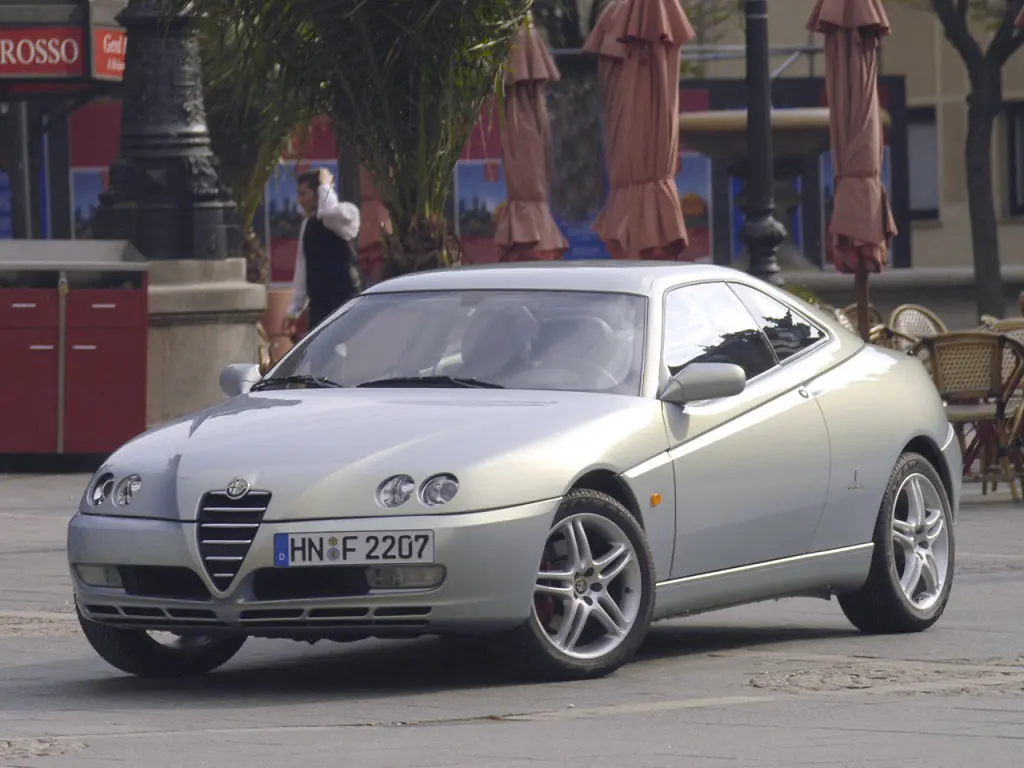The dawn of the new millennium marked a pivotal moment for Alfa Romeo. While other manufacturers chased volume sales with practical family cars, the Italians stubbornly stuck to their guns with the GTV (916). The 2003 facelift brought sharper lines and improved dynamics to this already captivating sports coupe, proving that Alfa’s commitment to driving pleasure remained unshaken.
This wasn’t just another update to an aging model. The refreshed GTV represented the culmination of decades of Alfa Romeo’s sports car expertise, packed into a svelte two-door body that turned heads then and continues to command attention today.
Italian Heart Under the Hood
The GTV’s powerplant options embodied the quintessential Italian approach to engineering – sophisticated, powerful, and full of character. The 2.0-liter Twin Spark engine, delivering 165 horsepower, offered a perfect balance of performance and reliability. However, the crown jewel was the 3.2-liter V6, a mechanical masterpiece producing 240 horsepower of pure Italian symphony.
The engines paired exclusively with manual transmissions, requiring driver engagement and rewarding proper technique. The front-wheel-drive layout, while unusual for a sports car, proved an inspired choice, offering exceptional traction and predictable handling.
“My V6 GTV starts every morning with a growl that turns heads. After 20 years, that engine still pulls like a train and sounds better than most modern sports cars.” – Mark Thompson, GTV owner since 2004
The powertrain’s real magic lies in its delivery – linear, responsive, and absolutely addictive. Even the base 2.0-liter unit propels the GTV to 60 mph in just over 8 seconds, while the V6 shaves nearly two seconds off that time.
Design That Turns Heads
The 2003 facelift enhanced the GTV’s already striking aesthetics with subtle yet effective updates. The redesigned front fascia showcased Alfa’s signature grille, while the profile maintained its distinctive wedge shape that seemed to move even when standing still.
Key visual elements that set the GTV apart include:
- dramatically raked windscreen with minimal A-pillars;
- distinctive side skirts integrated seamlessly into the body;
- characteristic rear haunches emphasizing the car’s width;
- elegantly tapered tail with integrated boot spoiler;
- distinctive five-hole alloy wheels that became an Alfa Romeo signature.
The design speaks volumes about Italian car culture – unashamedly bold yet surprisingly functional. Every panel serves a purpose, whether managing airflow or catching admiring glances.
Daily Driver or Weekend Warrior?
Behind the wheel, the GTV reveals its dual personality. The steering offers remarkable feedback, while the chassis balance inspires confidence through corners. The ride, though firm, never crosses into harshness territory.
“I’ve daily driven my GTV for three years now. Sure, it demands more attention than a modern car, but the driving experience makes every commute special.” – Sarah Miller, 2.0 Twin Spark owner
Regular maintenance proves crucial for reliability. The Twin Spark engines require timing belt changes every 36,000 miles, while V6 models need careful attention to their electrical systems. However, proper care rewards owners with remarkable dependability.
Living with the Legend
Inside, the GTV cocoons driver and passenger in typical Italian fashion. The cabin exemplifies focused design, with every control angled toward the driver. The deeply bolstered seats, wrapped in leather or alcantara, provide exceptional support during spirited driving.
Essential ownership considerations include:
- regular fluid checks and changes;
- inspection of electrical components;
- attention to rust prevention;
- specialized servicing at marque specialists;
- careful storage during winter months.
The trunk offers surprisingly practical space for weekend trips, while the rear seats, though snug, accommodate occasional passengers or extra luggage.
Beyond the Numbers
The GTV transcends mere transportation, representing one of the last authentic Italian sport coupes. It bridges the gap between classic Alfas and modern sports cars, offering a driving experience that remains uniquely engaging.
In today’s world of turbocharged uniformity, the GTV’s naturally aspirated engines and direct mechanical connection to the road feel refreshingly honest. It’s not just a car; it’s a testament to a time when character mattered more than convenience.
| Pros | Cons |
|---|---|
| Distinctive Italian styling that still turns heads | Limited rear seat space restricts practicality |
| Engaging driving experience with excellent feedback | Parts availability can be challenging |
| Strong performance from both engine options | Higher maintenance costs than contemporary rivals |
| Surprisingly practical for a sports coupe | Some electrical issues common with age |
| Growing classic status with potential value appreciation | Rust protection requires vigilant attention |
| Unique character lacking in modern alternatives | Specialized knowledge needed for maintenance |
| Excellent handling despite front-wheel drive layout | Premium fuel consumption, especially in V6 models |
The Alfa Romeo GTV (916) stands as a compelling choice for enthusiasts seeking a unique blend of style, performance, and Italian heritage. While it demands more attention than a modern sports car, the rewards of ownership far outweigh the extra effort required.

